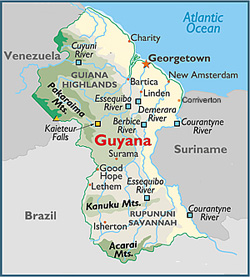Guyana is located on the northern border of South America bordering the Atlantic Ocean. Neighboring Venezuela, Suriname, and Brazil Guyana's capital is Georgetown. Guyana is unique in the fact that it shares more cultural similarities with the Caribbean rather than its Latin American neighbors. Guyana was named by Christopher Columbus in 1498, which is the Amerindian word for "land of many waters".
 |
| Map of the general landscape of Guyana. |
Guyana's population is made up of five main ethnic groups: Amerindians, Africans, Indians, Europeans, and Chinese. The largest ethnic group is the Indo-Guyanese. They originated in India and make up about 43.3 percent of the population. Next is the Afro-Guyanese holding 30.2 percent. 16.7 percent is going to be mixed Guyanese heritage. The remaining 9.1 percent is indigenous Guyanese people generally known as Amerindians.
Guyana is the only South American country that declares English as its official language. They speak a number of different languages, but Portuguese is the second most widely used language in Guyana.
In Guyana the President: David Granger, exercises executive authority within his government. He appoints the prime minister and other ministers, without being directly elected. Instead each party puts a leader forward who will become president if their party receives the most votes.
The forests and rivers of Guyana are full of all types of elaborate life including Jaguar, Giant Otter, Harpy Eagle, and the Guianan Cock-of-the-Rock attracting wildlife-watchers from all over the world. Guyana is especially known for its amazing selection of all types of different birds: Spotted Antpitta, White Plumed Antbird, and the more elusive Rufous-Winged Ground-Cuckoo; although bird watchers have to keep an eye out for the occasional Jaguar.
Their is so much "wildness" in Guyana that the main form of travel is through boat on one of the many rivers that create astounding waterfalls. Probably the most spectacular of the country's waterfalls is Kaieteur Falls, a natural wonder that has a vertical drop seven times that of Niagara Falls. The forests are so thick and unrelenting that they are almost impossible to navigate.
 Climate change poses a great threat
in Guyana. The country shares common threats with most of the developing world.
These threats are based mostly off of the misuse of natural resources by more
developing countries and projectors of this misuse on the futures economic and
physical sustainability. A problem has arisen mostly in the developing world
concerning large land acquisitions by larger governments and corporations known
as the global land rush. Countries are in shock of future projections of these
shortages of natural resources if misused as they are being today; in turn,
many of these countries with the economic capability are becoming more active
in the acquisition of land.
Climate change poses a great threat
in Guyana. The country shares common threats with most of the developing world.
These threats are based mostly off of the misuse of natural resources by more
developing countries and projectors of this misuse on the futures economic and
physical sustainability. A problem has arisen mostly in the developing world
concerning large land acquisitions by larger governments and corporations known
as the global land rush. Countries are in shock of future projections of these
shortages of natural resources if misused as they are being today; in turn,
many of these countries with the economic capability are becoming more active
in the acquisition of land.  Technological influence also plays a role
in the negative effects of climate change in developing countries. Some countries
may have the will to change the
current track of things without the technological capability it takes to
properly project and asses some possible ways to decrease the negative effects
of climate change. Although them seems to be many negative effects of climate
change it is true that each situation is unique in its conclusive effects as
countries present different problems along with different solutions. With the
help of many organizations on the regional, local, and national scale, negative
effects of climate change with be reduced to a minimum.
Technological influence also plays a role
in the negative effects of climate change in developing countries. Some countries
may have the will to change the
current track of things without the technological capability it takes to
properly project and asses some possible ways to decrease the negative effects
of climate change. Although them seems to be many negative effects of climate
change it is true that each situation is unique in its conclusive effects as
countries present different problems along with different solutions. With the
help of many organizations on the regional, local, and national scale, negative
effects of climate change with be reduced to a minimum. 
